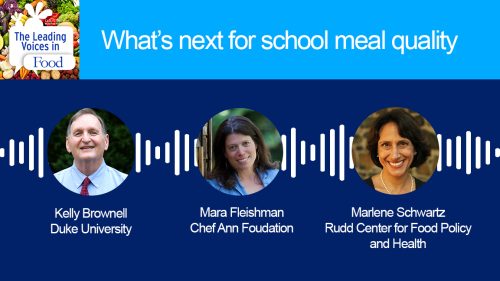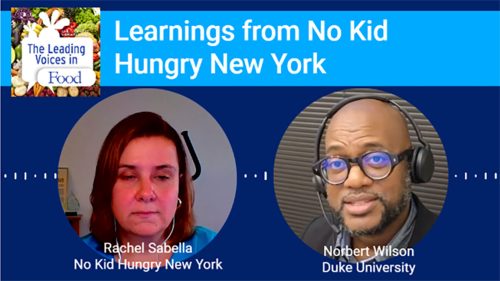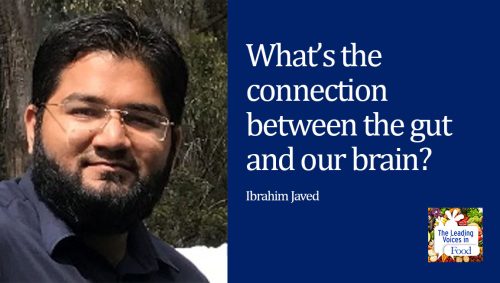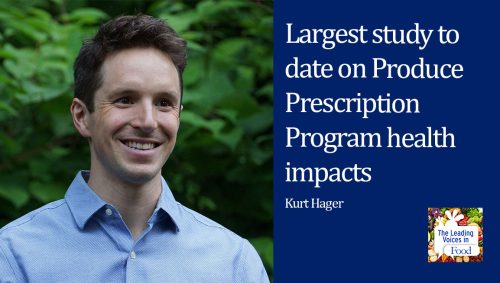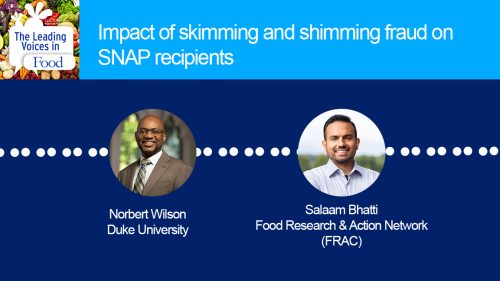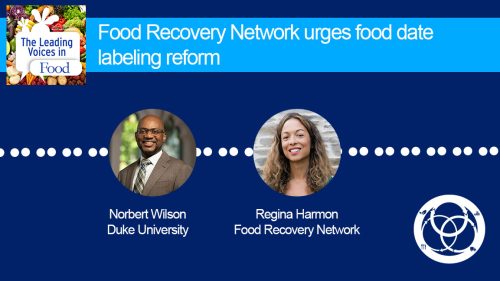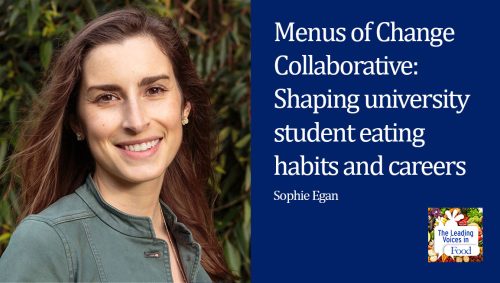The Leading Voices in Food
E2: Andrew Prentice on the Genetic Legacy of our Nutrition
You have likely heard the saying “You are what you eat.” But what if I told you that how well your parents were eating in the days and months before you were conceived may actually help to determine how your body works—at the cellular level—for your entire life? As it turns out, you were optimized to survive in your parents’ nutritional environment. The Leading Voices in Food podcast series, produced by the World Food Policy Center at Duke University, interviews Dr Andrew Prentice, professor of international nutrition that the London School of Hygiene and Tropical Medicine. Prentice is a distinguished scholar on the effects of diet on human health and disease and as a world leader in global health research, he has made major contributions in many areas, two of which are the regulation of Human Energy Balance and obesity and the effects of malnutrition on maternal and child health and poor populations.
Subscribe: Apple Podcasts | TuneIN | YouTube Music | SoundCloud | PocketCasts | Radio Public
Tags: Child Development & Nutrition | Childhood Obesity | Food Insecurity | Food, Psychology & Neuroscience |
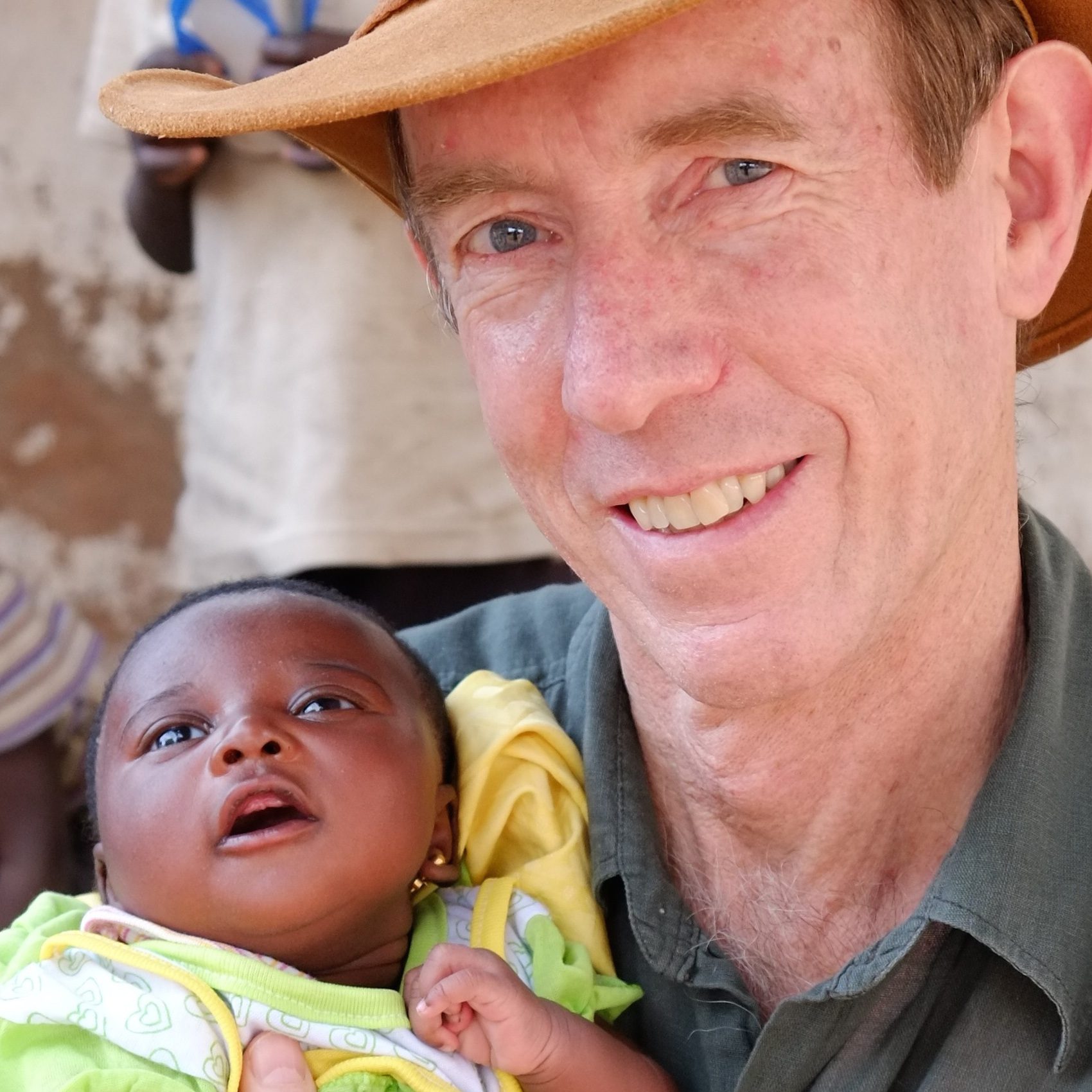
Dr Andrew Prentice, professor of international nutrition that the London School of Hygiene and Tropical Medicine. He is founder and head of the United Kingdom’s medical research councils, International Nutrition Group in Gambia, Africa. Andrew directs research focused largely on maternal and child health in developing countries with emphasis on early human growth and development, iron infection than anemia, nutritional genetics and epigenetics and calcium and vitamin D and bone health. Andrew is a distinguished scholar on the effects of diet on human health and disease and as a world leader in global health research, he has made major contributions in many areas, two of which are the regulation of Human Energy Balance and obesity and the effects of malnutrition on maternal and child health and poor populations.
Interview Summary
You live and work in a very remote setting in the middle of the African Bush. Could you explain why?
I do live a very strange life, but at the same time it’s a very wonderful one. I live within a community that we have been studying–and when I say studying, that sounds as if it’s us studying them. Really, they’ve really been participating in the work we do for over seven decades. Can you believe it? And they have a very good understanding that they’re contributing to global health. So I love this population very much. I’ve been working with them for 40 years and not only that, it gives us some really great opportunities to do some unusual science and I’ve come to the conclusion that the best way I can do that is actually to live here within that community.
So what are some of the main nutritional challenges for people living in that part of the world?
Well, let’s start off with the sort of global picture and what the World Health Organization and others would genuinely generally articulate in terms of stunting. So eradicating stunting has been part of the goal, reducing it by half has been part of the Millennium Development Goals, going onto the Sustainable Development Goals. And yet there are still at least $160 million stunted children around the world. And it’s the World Health Organization target to reduce that by half by 2025, which is very ambitious. Now, why does it matter? I don’t care if someone is shorter or taller than another person. But the problem is that stunting is a reflection of the fact that a child has been undernourished for many months, probably years. And so if you look at the patterns across the poor countries of this world, you see that their growth falls away from what would be the normal standard reference curves very rapidly in the first two years of life. And that then has an effect on brain development and cognitive development, and what we call human capital. So that’s why we care about it.
Are there also affects on resistance to disease?
Indeed, so stunted child will be much more likely to die and just in his normal life, but also if admitted to hospital will have a much higher case fatality rate. So we do know that this marker of former under-nutrition is a really strong prognostic indicator of how well or badly a child will do.
You’re helping paint a picture of the human toll of this because otherwise we just get lost in the numbers, you know, so many millions of people are under nourished and the children affected by stunting. But you’ve really made it pretty clear that there are very dramatic effects on the lives of children.
There are indeed and that’s what drives me. I mean on the one hand I’m fascinated, but on the other hand determined to try and do something about it. So that then really brings us on to the next challenge, which is how well have you guys in the nutrition field being doing? And unfortunately the answer to that is very badly. So if we try to intervene with all the sensible things, you know–feeding children better, educating mothers how to look after them better, and we do that even under the rigorously controlled conditions of a randomized trial…we find that we can only get back about one eighth of the deficit in terms of stunting. So that is extremely discouraging and then on top of that, recently people have said, well the nutrition doesn’t do so well because of the unhygienic conditions that people are living in. So there have just recently been published, huge trials that have what’s called wash water, sanitation and hygiene, and they’ve really tried to improve the sanitation and hygiene. But unfortunately they have had an absolutely no result. Zero effect on growth. So we’re really scratching our heads as to why we can’t fix this move the needle. And that’s one of the things that drives me to do really quite basic fundamental research. I believe that we just don’t understand things well enough and when we do understand them better, we’ll be able to fix them better.
Can you give an example or two of the kind of basic research you’re talking about?
I’d love to. I’ll give you a couple of stories. The first one is about iron and anemia. So the children here, by the time they’re a year old, are profoundly iron deficient and anemic way below even the fifth percentile of the African American data. So they’re very anemic. And the question has been why and what can we do about it? So iron is incredibly cheap. It’s easy to give it out to children and yet still, when we do that, again under the rigorous conditions of trials, we don’t improve very much. We got a bit of an improvement, but we don’t certainly don’t get rid of the anemia. And so the recent insight we’ve had on that has been elucidated by the discovery of this new hormone Hepcidin. So Hepcidin is the master regulator of iron metabolism. And I like to use the analogy that Hepcidin is to iron what insulin is to glucose.
It really is that important and it’s an exquisite molecule it’s produced by the liver. But evolution has taught it to do two things. First of all, it’s senses iron status. And secondly, it senses threat of infection. Now what’s important about these two things is that iron and infection have been intimately linked over evolutionary time. So iron feeds bugs, feeds infections at least as much if not more than it feeds the human host. So that’s why the molecule has learned to detect these two things. Now, what we’ve discovered very recently is that actually children are up-regulating their Hepcidin in response to low grade inflammation and the threat of infection, and that when Hepcidin is upregulated, it’s positively blocking the absorption of iron in the duodenum. So, that’s really a really important discovery. And incidentally, what seems to be driving up the Hepcidin is respiratory infections. So for the first time, we’re able to link the probability…this needs further work, but the probability that actually it’s actually respiratory infections that are driving up Hepcidin, which is blocking iron absorption which is this causing a secondary anemia. And, if that’s all true, that points to a direct novel directions for therapeutic interventions. And so it’s completely turned our old nutritional feeding on its head. Doctors in the past would assume that children are very poorly evolved to absorb iron: so these poor little things, we’ve got to throw lots of iron at them to overcome this. And in fact what we have now discovered is that in fact they’re spending a lot of physiological time positively blocking iron absorption.
You’re painting a picture that the body is sequestering iron so that it doesn’t feed infections that could then prosper even more in the body. Is Malaria a player in this picture?
Yes, malaria is a big part of this. What is now clear that being on deficient and anemic is very protective against malaria in young kids. So we’re sort of faced with this dilemma. What do we do about this? On the one hand, you could say, well, it’s best to leave the children anemic because they’re protected from malaria. I would not subscribe to that view at all. I would say, no, we’ve got to get rid of the malaria. We’ve got to get rid of the infections and we’ve got to give these children iron in order to improve their cognitive development and brain function.
So let’s look at a bigger picture of the world’s nutrition landscape and I know that it’s changed a lot during the time you’ve been working on global health. What are some of the key trends that you’ve seen in the nutrition landscape across the world?
So I’ve described to you already the struggle we have with getting rid of stunting. Now the unpleasant paradox here is that actually as countries pass through the demographic economic transition and become richer then stunting disappears really quite quickly and anemia disappears quickly. So if we look at DHS surveys over various generations, South America, for instance, is a good example, where they used to be a ton of stunting and now it’s really disappearing. Okay. That’s the good news. The bad news is of course it’s inevitably replaced by obesity and overweight and the consequent problems associated with that.
Are you seeing that even in places like Gambia?
We see it among the adults and particularly adult women. It’s a really strange phenomenon here. There’s very little obesity and overweight in men, increasing, but there’s not that much. Whereas in women we have very high rates and so that tells us something interesting–if men have almost none, and women have a lot, it’s not genetic. It’s very much behavioral and you know, women are the ones who produce all the food and they also like to be fat and men like women fat. So there’s quite a lot of social stuff going on here as well.
Are there any indications that obesity rates are increasing in children?
Not yet in the Gambia but elsewhere in Africa? Yes, definitely. And you do see some of the very well off Gambian kids who are definitely overweight. So, I mean in this is interesting. I know you because you’re very familiar with this field, but you will know probably better than I, that you get this switchover, that obesity starts off being a disease of the rich in poor countries, but then as countries develop it switches over and it becomes a disease of the poor. And we will see that transition I’m quite sure in Africa, and I think we are seeing it already as things develop.
Some of your work has to do with the topic of epigenetics and not everyone listening will be fully familiar with this term. Could you explain what epigenetics is and the nature of your work on that topic?
Yes, certainly. So I think everybody will be familiar with genetics. So the genes we inherit from our parents, and everybody will know that there are, give or take and very, very rare mutations within our lifetimes. That they’re the same. And every cell of the body contains exactly the same DNA apart from the germ cells, the egg and the sperm, but every other cell contains. It’s actually the same DNA. So the question is how does that same message create an eye cell or a liver cell or a kidney cell, and that, amongst other things is regulated by epigenetics. So epigenetics refers to the signals and there are many ways that this can occur. I’ll keep it simple by just talking about methylation. So methyl groups are added to certain areas of the genome and these can modulate how the genes are expressed. So I like to use a musical analogy. Genes are the actual notes that have been written by the composer on the staff and epigenetics relates to the grace notes or the instructions the composer writes on top of it to play this faster or slower or fortissimo or pianissimo. So that’s a really good analogy actually. And that’s what epigenetics is about.
What work are you doing on this topic?
Well, we’ve been so lucky here. We’ve come across some fascinating findings. We have a very profound seasonality in the Gambia. So, I’m speaking to you in the end of October, the rain has just finished, we probably won’t get another rain for another eight months now. So that changes the foods that are consumed, the whole dietary patterns, very profoundly. So you have a quasi-experiment of nature. People are randomized, or conceptions occurring in different months are randomized, to a different nutritional background. And to cut a long and very complex story short, what we’ve discovered is that the day a baby is conceived or the month it’s conceived in, has a really profound effect on certain of the marks within the epigenome. And these relate to marks that are laid down in the very first few days of life. So if I could expand on that a little bit, when sperm meets egg, each of those has epigenetic marks from the parents. So the sperm carries the father’s epigenetic marks, which incidentally were laid down during the father’s fetal life. So that means that the paternal grandmother was influencing those marks and the egg, those marks are laid down in the probably in the adolescent period and in the 14 weeks leading up to the release of that day. Now what happens when they fuse is that most of those marks are removed. It’s called erasure and they have to be removed in order to create pluripotent cells that can then become things other than sperm and egg. They can become all the other cells that are needed for the body. And so the erasure happens very, very quickly and then patterns are laid back down within the first seven, eight, nine days of conception. And that’s what we study. And as I say, we’ve found that there a very profound differences in those patterns that are laid down in the very first few days of human development according to the month of babies conceived in. And it’s really quite remarkable. We hope its going to tell us a lot about how parental nutrition can affect the lifelong health of these babies and any babies around the world.
What strikes me as being profoundly important, that certainly a child inherits the genetics from their parents, but it sounds like what’s going on in the lives of the parents during critical times like prior to pregnancy and things will affect the child’s genetics beyond what the parents just would have passed along anyway. Is that correct?
We think so, tied up in this are some intricate, probably evolutionary tricks that have developed over many, many millennia. It would make sense that a baby develops in the way that would be best suited to its environment. So if these areas of the genome that we’re studying are able to detect the nutritional circumstance that that egg finds itself in the fallopian tube and in the womb as it’s embedding, which of course will reflect the mother’s nutritional status. If it can detect that, it can record what it sees and then it can adapt the phenotype, adapt the baby according to that information. That would make a lot of sense and we think, we speculate, that that’s what’s going on and there’s a huge amount of work ahead of us to try and understand the biology. But actually, more importantly in a way, although we think we need to understand the biology first, I was going to say more importantly is would this give what we could call it a pathway to impact. If we understand this better, can we advise mothers, and fathers incidentally, how better to eat in the weeks and months leading up to them conceiving a baby, which would ultimately, we hope, have a lifelong effect on that baby’s health.
Now, the intriguing thing, and the thing I really love, is that we’re able to study this simply because of this wonderful experiment with nature. But I speculate that this affects any moms around the world, so it’s not just an issue for Gambian mums or African mums. I think this will be a universal finding once we can sort it all out.
Your work contributes to the science showing that early malnutrition experiences put an individual at risk for things like obesity and diabetes later in life. Could you explain how and why that works? But also explain, if you would, whether they’re epigenetic possibilities there like, do malnutrition experiences in a mother or father contribute to the likelihood of child might be a risk for those things later in life.
Indeed. Thanks for the question, because that opens up a couple of answers. The best thing is to just expand a little bit on what you’ve said about what we call the developmental origins of health and disease theory. So we have known since the days of Elsie Winterson and Ari McCants at Cambridge, but brought to the fore, really by David Barker in Southampton, that babies’ fetal experiences which can be measured by their size at birth have a profound effect on their risk of, for instance, heart disease or diabetes or hypertension as you’ve indicated, some six or seven decades later. So the question as you posed it is, well, how, how could those facts be linked together? One answer of course, is that what it could be an anatomical change. If the baby hasn’t gotten enough of the right nutrients to develop enough renal tubules, then it will have a deficit of renal tubules for the whole of its life, which would cause a potentially drive up hypertension. So that’s one possibility. The hot money has been put on epigenetics, that maybe epigenetics is a process by which the epigenomes could be affected by the early undernutrition and could then be giving this unhealthy readout for the rest of that person’s life. And that’s part and parcel of what we’re trying to get to the bottom of it. Just to say again, that the reason for really wanting to do this so fast is that it should lead us, I think, to better next generation interventions if we can solve that. All the biology that’s going on.
You mentioned earlier in the podcast that the sustainable development goals wished to reduce stunting by half, by the year 2025, and yet there are so many millions of children around the world affected by stunting. Do you see any hope that’s an achievable goal?
Oh, definitely. Yes. I think the world is progressing and I think one of the very important things for we nutritionists to keep in mind is that the world is changing and in a way that’s one of the reasons I love to live and work among the population because I can watch the change that’s going on. One of the things that happens here actually is that a lot of money is sent back to families here from people who have migrated abroad. So people who drive your taxi around Duke or anywhere else, are possibly Gambians and possibly sending money back and that’s having a profound effect. So I think at the end of the day, wealth and the transmission of wealth and the sharing of wealth around the world will help these things and they will sort themselves out at the deficit once again of moving almost straight over and inevitably over into the problems of overweight and obesity. But I do see a lot of hope. There’s one other thing I’d like to mention, which is that I also mentioned that these wash interventions were profoundly unsuccessful. And I think my interpretation of what’s gone on there is that they simply haven’t been ambitious enough. They’ve put on the hat of, well, whatever we do must be affordable for very poor people and for poor governments. And I think that’s, I mean it was a good start, but it’s almost insulting saying that we must keep poor people in poverty and there’s nothing better we can do then, you know, offer them soap and tell them how to wash their hands. I think people have a right to live in very good housing. I think everybody has an aspiration to live in very good housing. And once that occurs, I think a lot of the nutritional problems will disappear. So it’s a bit intriguing to hear a nutritionist saying, actually nutrition just at the moment might not be able to solve all this. We’ve really got to have help from what we call them, nutrition sensitive interventions, in concert with the nutrition specific intervention. So that’s the way that my thinking at least is going.

